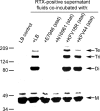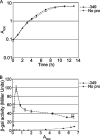Growth phase regulation of Vibrio cholerae RTX toxin export
- PMID: 17189368
- PMCID: PMC1855747
- DOI: 10.1128/JB.01766-06
Growth phase regulation of Vibrio cholerae RTX toxin export
Abstract
Vibrio cholerae, the causative agent of the severe diarrheal disease cholera, secretes several "accessory" toxins, including RTX toxin, which causes the cross-linking of the actin cytoskeleton. RTX toxin is exported to the extracellular milieu by an atypical type I secretion system (T1SS), and we previously noted that RTX-associated activity is detectable only in supernatant fluids from log phase cultures. Here, we investigate the mechanisms for regulating RTX toxin activity in supernatant fluids. We find that exported proteases are capable of destroying RTX activity and may therefore play a role in the growth phase regulation of toxin activity. We determined that the absence of RTX toxin in stationary-phase culture supernatant fluids is also due to a lack of toxin secretion and not attributable to solely proteolytic degradation. We ascertained that the T1SS apparatus is regulated at the transcriptional level by growth phase control that is independent of quorum sensing, unlike other virulence factors of V. cholerae. Additionally, in stationary-phase cultures, all RTX toxin activity is associated with bacterial membranes or outer membrane vesicles.
Figures









Similar articles
-
Vibrio cholerae strains with mutations in an atypical type I secretion system accumulate RTX toxin intracellularly.J Bacteriol. 2004 Dec;186(23):8137-43. doi: 10.1128/JB.186.23.8137-8143.2004. J Bacteriol. 2004. PMID: 15547287 Free PMC article.
-
In vivo covalent cross-linking of cellular actin by the Vibrio cholerae RTX toxin.EMBO J. 2000 Oct 16;19(20):5315-23. doi: 10.1093/emboj/19.20.5315. EMBO J. 2000. PMID: 11032799 Free PMC article.
-
Identification of a domain within the multifunctional Vibrio cholerae RTX toxin that covalently cross-links actin.Proc Natl Acad Sci U S A. 2004 Jun 29;101(26):9798-803. doi: 10.1073/pnas.0401104101. Epub 2004 Jun 15. Proc Natl Acad Sci U S A. 2004. PMID: 15199181 Free PMC article.
-
Rules of Engagement: The Type VI Secretion System in Vibrio cholerae.Trends Microbiol. 2017 Apr;25(4):267-279. doi: 10.1016/j.tim.2016.12.003. Epub 2016 Dec 24. Trends Microbiol. 2017. PMID: 28027803 Free PMC article. Review.
-
Regulation of virulence in Vibrio cholerae.Int J Med Microbiol. 2001 May;291(2):81-8. doi: 10.1078/1438-4221-00104. Int J Med Microbiol. 2001. PMID: 11437342 Review.
Cited by
-
The regulator HlyU, the repeat-in-toxin gene rtxA1, and their roles in the pathogenesis of Vibrio vulnificus infections.Microbiologyopen. 2012 Dec;1(4):502-13. doi: 10.1002/mbo3.48. Epub 2012 Nov 28. Microbiologyopen. 2012. PMID: 23233275 Free PMC article. Review.
-
RTX proteins: a highly diverse family secreted by a common mechanism.FEMS Microbiol Rev. 2010 Nov;34(6):1076-112. doi: 10.1111/j.1574-6976.2010.00231.x. FEMS Microbiol Rev. 2010. PMID: 20528947 Free PMC article. Review.
-
Promotion of colonization and virulence by cholera toxin is dependent on neutrophils.Infect Immun. 2013 Sep;81(9):3338-45. doi: 10.1128/IAI.00422-13. Epub 2013 Jun 24. Infect Immun. 2013. PMID: 23798539 Free PMC article.
-
Potential Survival and Pathogenesis of a Novel Strain, Vibrio parahaemolyticus FORC_022, Isolated From a Soy Sauce Marinated Crab by Genome and Transcriptome Analyses.Front Microbiol. 2018 Jul 6;9:1504. doi: 10.3389/fmicb.2018.01504. eCollection 2018. Front Microbiol. 2018. PMID: 30034383 Free PMC article.
-
RNA-seq analysis identifies new genes regulated by the histone-like nucleoid structuring protein (H-NS) affecting Vibrio cholerae virulence, stress response and chemotaxis.PLoS One. 2015 Feb 13;10(2):e0118295. doi: 10.1371/journal.pone.0118295. eCollection 2015. PLoS One. 2015. PMID: 25679988 Free PMC article.
References
-
- Balsalobre, C., J. M. Silván, S. Berglund, Y. Mizunoe, B. E. Uhlin, and S. N. Wai. 2006. Release of the type I secreted α-haemolysin via outer membrane vesicles from Escherichia coli. Mol. Microbiol. 59:99-112. - PubMed
-
- Benítez, J. A., L. García, A. Silva, H. García, R. Fando, B. Cedré, A. Pérez, J. Campos, B. L. Rodríguez, J. L. Pérez, T. Valmaseda, O. Pérez, M. Ramírez, T. Ledón, M. D. Jidy, M. Lastre, L. Bravo, and G. Sierra. 1999. Preliminary assessment of the safety and immunogenicity of a new CTXφ-negative, hemagglutinin/protease-defective El Tor strain as a cholera vaccine candidate. Infect. Immun. 67:539-545. - PMC - PubMed
-
- Boardman, B. K., and K. J. Satchell. 2005. The Atypical TISS for secretion of Vibrio cholerae RTX toxin is regulated by growth phase, abstr. B-280, p. 81. Abstr. 105th Gen. Meet. Am. Soc. Microbiol., Atlanta, GA.
Publication types
MeSH terms
Substances
Grants and funding
LinkOut - more resources
Full Text Sources
Molecular Biology Databases

